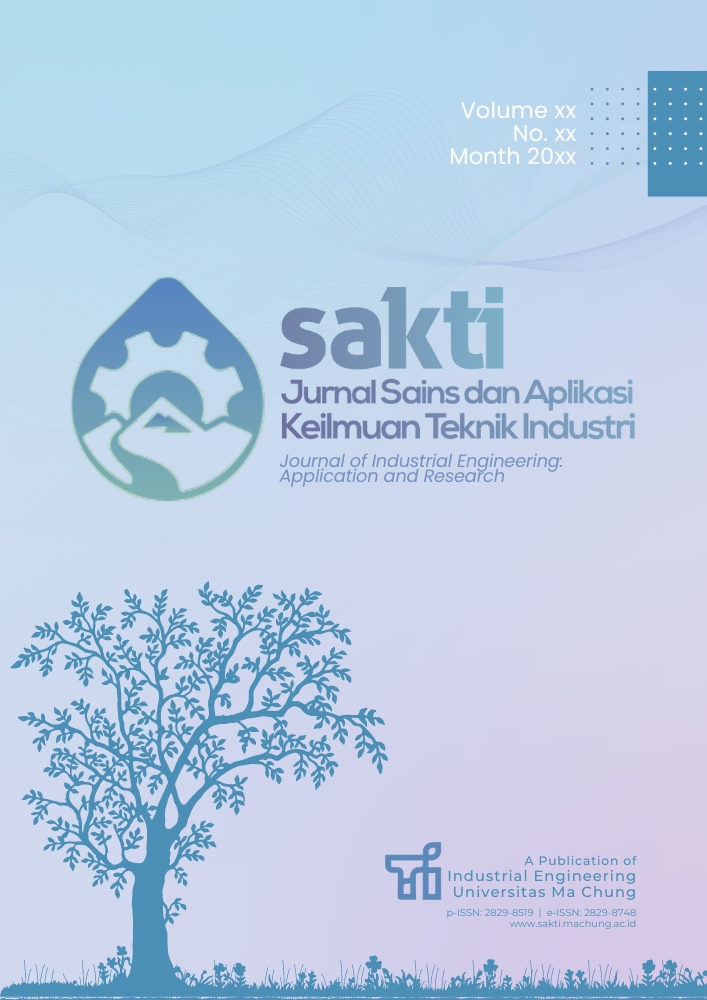Analysis of Pipe Water Inlet EW010 Quality Control Using Six Sigma and Failure Mode and Effect Analysis
Case Study: PT Wijaya Karya Industri dan Konstruksi
DOI:
https://doi.org/10.33479/sakti.v4i1.87Keywords:
Pipe Water Inlet EW010, Six Sigma, failure mode and effect analysis, root cause analysisAbstract
PT Wijaya Karya Industri dan Konstruksi has businesses in the fields of Steel, Plastic, Pressing and Casting (PPC) Manufacturing and heavy construction equipment. The PPC factory produces various kinds of manufacturing components, one of which is vehicle spare parts made from metal which are produced using a casting process. One of the products produced using a casting process is Pipe Water Inlet EW010. There are many Pipes Water Inlet EW010 defective products with an average of 52% defective products in July-August 2023. The research was conducted to analyze the sigma value and determine the factors of product defects and the impact of the defects to provide suggestions for product quality improvement. In this research, the method applied is the Six Sigma method and FMEA, by implementing DMAIC (Define, Measure, Analyze, and Control). From this research, the results showed that the most common defects were Leaking, Pen/core, and Porous, namely 89% cumulative. Pipe Water Inlet EW010 products are currently at level 2.44 sigma so corrective action needs to be taken to reach the six-sigma level. By applying the FMEA method, it can be seen that the most significant and most frequently occurring product defects are caused by poor core quality and work method errors. Therefore, the recommended alternative repair solution is to improve the quality of the cores used and improve work methods. The results show an increase in the sigma level value from 2.44 to 2.86 and a decrease in average defects from 52% to 23%.
References
Alfarizi, N., Noya, S., & Hadi, Y. (2023). Pengendalian Kualitas Menggunakan Metode Six Sigma dan FMEA untuk Mengurangi Reject Material Preform pada Industri AMDK. Jurnal Sains dan Aplikasi Keilmuan Teknik Industri (SAKTI), 3(1), 1-12. https://doi.org/10.33479/jtiumc.v3i1.41
Andriana, J., & Noya, S. (2016). Application of FTA and FMEA method to improve sugar production process quality. Jurnal Spektrum Industri, 14(2), 129-146.
Ardyansyah, R. (2019). Analisis penyebab cacat produk menggunakan metode Failure Mode and Effect Analysis (FMEA) pada PT Sinar Sanata Electronic Industry [Undergraduate thesis, Universitas Medan Area]. UMA Repository. https://repositori.uma.ac.id/bitstream/123456789/11215/1/158150017%20-%20Rizky%20Ardyansyah%20-%20Fulltext.pdf
Puspitaloka, M.A.C.D., & Ekawati, Y. (2022). Analisis Perbaikan Kualitas Proses Produksi di PT XYZ Menggunakan Metode Fuzzy FMEA. Jurnal Sains dan Aplikasi Keilmuan Teknik Industri (SAKTI), 2(1), 11-18. https://doi.org/10.33479/jtiumc.v2i1.19
Ishikawa, K. (1990). Introduction to Quality Control. Tokyo: 3A Corporation.
Jucan, G. (2005). Root Cause Analysis for IT incidents Investigation. Retrieved April 30, 2015, from http://www.docstoc.com/docs/16171902/Root-Cause-
Masdalifah, M. (2019). Analisa perbaikan kualitas pada proses pengolahan logam di CV. Sispra Jaya Logam menggunakan metode Six Sigma [Undergraduate thesis, Universitas Islam Negeri Sultan Syarif Kasim Riau]. UIN-SUSKA Repository. https://repository.uin-suska.ac.id/21830/1/PDF%20FIX%20MASDALIFAH.pdf
Saputro, R., Winarni, W., & Yusuf, M. (2016). Pendekatan Six Sigma, FMEA, dan Kaizen Sebagai Upaya Peningkatan Perbaikan Kualitas Produksi Pengecoran Logam Di PT. Mitra Rekatama Mandiri. Jurnal REKAVASI, 4(1), 47-52.
Sudjana, H. (2008). Teknik Pengecoran Jilid 1. Jakarta: Direktorat Pembinaan Sekolah Menengah Kejuruan.
Susanti, Y.E. (2015). Usulan Perbaikan Kualitas Produk Hanger Kawat Pakaian Dewasa dengan Menggunakan Metode Failure Modes And Effects Analysis (FMEA) Pada UD Mahkota Hanger Kediri [Unpublished undergraduate thesis]. Universitas Airlangga.









